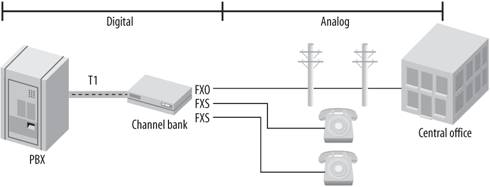2.3. Telephony Hardware
If you are going to connect Asterisk to any
legacy telecommunications equipment, you will need the correct
hardware . The hardware you require
will be determined by what it is you want to achieve.
2.3.1. Connecting to the PSTN
Asterisk allows you to seamlessly bridge
circuit-switched telecommunications networks with packet-switched data
networks. Because of Asterisk's open architecture (and open
source code), it is ultimately possible to connect any
standards-compliant interface hardware. The selection of open
source telephony interface boards is currently limited, but as
interest in Asterisk grows, that will rapidly change. At the moment, one of the most popular and
cost-effective ways to connect to the PSTN is to use the interface
cards that evolved from the work of the Zapata Telephony Project
(http://www.zapatatelephony.org).
2.3.1.1. Analog interface cards
Unless you need a lot of channels (or a have lot
of money to spend each month on telecommunications facilities),
chances are that your PSTN interface will consist of one or more
analog circuits, each of which will require a Foreign eXchange
Office (FXO) port.
Digium, the company that sponsors Asterisk
development, produces the most popular analog interface card for
Asterisk , known as the
TDM400P. The TDM400P is a four-port
base card that allows for the insertion of up to four daughter
cards, which deliver either FXO or Foreign eXchange Station (FXS)
ports. The TDM400P can be purchased with these cards preinstalled,
and Digium has designated part numbers to describe these
configurations. The naming convention is TDM x y B, where x and y are
numbers representing the quantity of FXS and FXO cards on the board,
respectively. Check out Digium's web site (http://www.digium.com) for more
information about this card.
An older card produced by Digium was known as
the X100P. It is no longer available from Digium, but you may be
able to find a clone of this card.
Another company that produces
Asterisk-compatible analog cards is Voicetronix. They have three
Asterisk cards in their analog lineup: OpenLine4, OpenSwitch6, and
OpenSwitch12.
2.3.1.2. Digital interface cards
If you require more than 10 circuits, or require
digital connectivity, chances are you're going to be in the market
for a T1 or E1 card. Bear in mind, though, that the monthly charges
for a digital PSTN circuit vary widely. In some places, as few as
five circuits can justify a digital circuit; in others, the
technology may never be cost-justifiable. The more competition
there is in your area, the better chance you have of finding a good
deal. Be sure to shop around.
The Zapata Telephony Project originally produced
a T1 card, the Tormenta, that is the ancestor of most
Asterisk-compatible T1 cards. The original Tormenta cards are now
considered obsolete, but they do still work with Asterisk.
Currently, the only company known to be producing these cards is
Varion.
Digium makes several different digital circuit
interface cards. The features on the cards are the same; the
primary differences are whether they provide T1 or E1 interfaces,
and how many interfaces each card provides. Although it's
technically possible, the general consensus in the Asterisk
community is that no more than one of these cards should be
deployed in a single system.
Sangoma, who have been producing open source WAN
cards for many years, have recently added Asterisk support for
their T1/E1 cards. Sangoma's cards contain
powerful field-programmable gate arrays (FPGAs), which make them
extremely flexible. In an Asterisk environment, for example, they
have been programmed to interface with the Zapata channel
driver.
2.3.1.3. Channel banks
A channel bank
is loosely defined as a device that allows a digital circuit to be
de-multiplexed into several analog circuits (and vice versa). More
specifically, a channel bank lets you connect analog telephones and
lines into a system across a T1 line. Figure 2-2 shows how a channel bank
fits into a typical office phone system.

Although they can be expensive to purchase, many
people feel very strongly that the only proper way to integrate
analog circuits and devices into Asterisk is through a channel
bank.
2.3.1.4. Other types of PSTN
interfaces
Many VoIP gateways exist that can be configured
to provide access to PSTN circuits. Generally speaking, these will
be of most use in a smaller system (one or two lines). They can
also be very complicated to configure, as the interaction between
the various networks and devices requires a solid understanding of
both telephony and VoIP fundamentals. For that reason, we will not
discuss these devices in detail in this book. They are worth
looking into, howeverpopular units are made by Sipura, Grandstream,
Digium, and many other companies.
Another way to connect to the PSTN is through
the use of Basic Rate Interface (BRI )
ISDN circuits . BRI is a digital
telecom standard that specifies a two-channel circuit that can
carry up to 144 kbps of traffic. It is very rarely used in North
America and most of the rest of the world, but it's quite popular
in Europe. Due to the variety of different ways this technology has
been implemented, we will not be discussing BRI in very much detail
in this book.
2.3.2. Connecting Exclusively to a
Packet-Based Telephone Network
If you do not need to connect to the PSTN,
Asterisk requires no hardware other than a server with a Network
Interface Card.
However, if you are going to be providing music
on hold or conferencing and you have no physical timing source
, you will need the ztdummy Linux kernel module. ztdummy is a clocking mechanism designed to
provide a timing source to a system where no hardware timing source
exists. In Version 2.4 of the Linux kernel, to use ztdummy you must have a UHCI-type USB
controller on your motherboard. In
Linux 2.6, that requirement is no more.
 |

